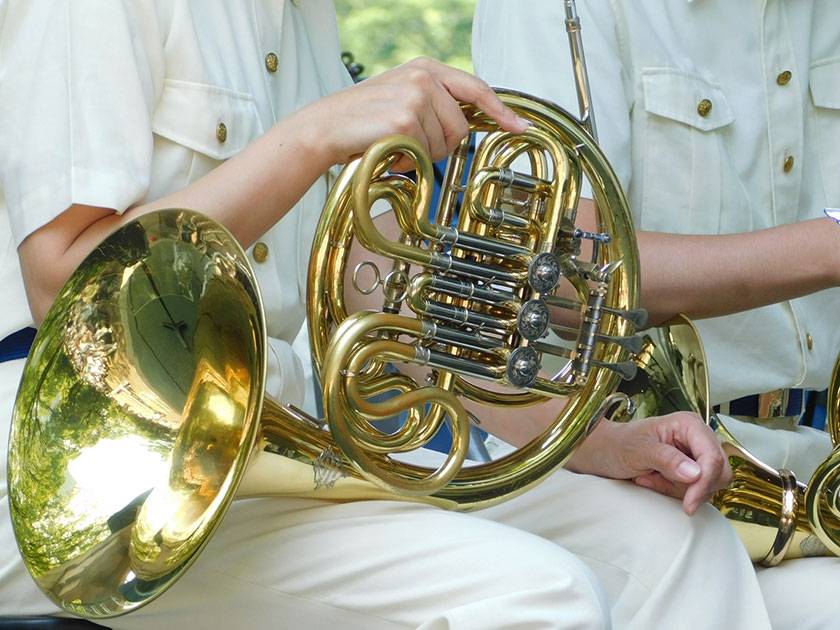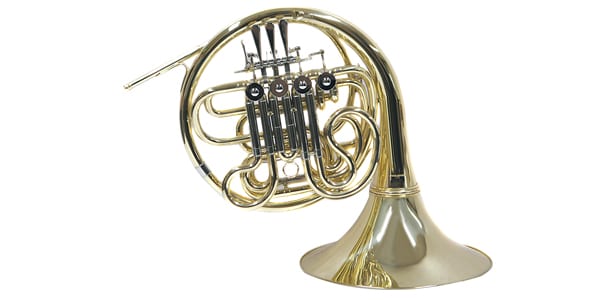Hello everyone. This time, I would like to introduce the "horn", which is a big part of brass bands and orchestras. (This time, I will focus on the French horn, which is a brass instrument.) People who are not familiar with musical instruments often call it the "snail-like instrument," but once you get acquainted with it, it is a very attractive instrument. Let's take this opportunity get to know it!

1. What is the origin of the horn?
The origin of the horn is said to be a "horn whistle" made from the horns of animals. It was mainly used as a means of communicating while hunting. At that time, the horn was a straight-tube instrument called the natural horn, and had no rotary mechanism. In other words, the sound was changed only by lip slurs. Soon after, they started to wind the tube around so that it could be blown while riding a horse, and carried over the shoulder. That created the shape of today's “snail”. In addition, the mechanism behind the horn's unique bell was designed to keep it out of the way at the time. After that time, a playing style was created in which the pitch was changed by thrusting the hand into the bell together with lip slurs. This playing style is called the "Geschtop playing style". And then the rotary mechanism was added. With this mechanism, it became possible to play parts that could not be played stably before that time.
2. What kind of French horns are there now?
French horns are classified into "single horns", "double horns (full double horns, semi-double horns)" and "triple horns".
A. Single horn
Single horns are made entirely of monotone tubes. The F tube is most common, but many people also like the B♭ tube. The F tube produces a sound closest to the natural horn. The tone is good, but the long tube makes it easy to make mistakes. On the other hand, the B♭ tube is said to be easy to use, but has an inferior tone.
B. Double horn
The double horn combines the advantages of the two single horns. It is considered to be the mainstream in modern times. The main feature is that you can switch between two tones with a single instrument. There are two types of doubles, the "semi-double" and the "full-double" (the difference here is quite difficult to explain, so please check this out for yourself if you’re interested in learning more). The player uses the thumb lever to switch between the two tones. There are various combinations of tones, but the F/B♭ double horn, which is a combination of the F tube and the B♭ tube, is the mainstream.

C. Triple horn
And then there is the triple horn, which allows you switch between three tones. This is a new mechanism developed around 1996. There are three tubes, the High-F tube, which is easy to blow in the high range but has a muddy mid-low range, and the F tube and B♭ tube mentioned above. Thanks to this horn, it became possible to take on a larger variety of pieces in a wider range of genres. However, the triple horn is difficult to produce and has a large amount of metal, so it is quite heavy and simply requires a lot of physical strength to play. In addition, the instrument itself is expensive, so it is not widely used yet.
3. What is the special horn, the Wiener horn?
There is also a special horn that is different from the French horn. It’s called the Vienna Horn (Wiener Horn in German). Unlike the rotary mounted on a normal horn, this has a valve called the Vienna (Wiener) valve. The tone is dark and heavy, and it has a structure closer to that of the natural horn. The difference between this and the French horn is obvious with just one look. In terms of the mechanism, it is an F tube single horn. It is also well-known that great skill is required to play this. And, it is principally used by the Vienna Philharmonic Orchestra. When listening to a Vienna Philharmonic performance, be sure to listen for the sound of the horn.
Many orchestral pieces have 4 horn parts (some, such as Mahler, have 8 parts). In other words, there are many horns. The beautiful chords produced with horns are very pleasant to listen to. Not only that, even if the horn is used for a solo, the sound is so comfortable that you will fall in love with it. Were you able to learn a little about the charming horn? I hope this helped you. See you again!


























